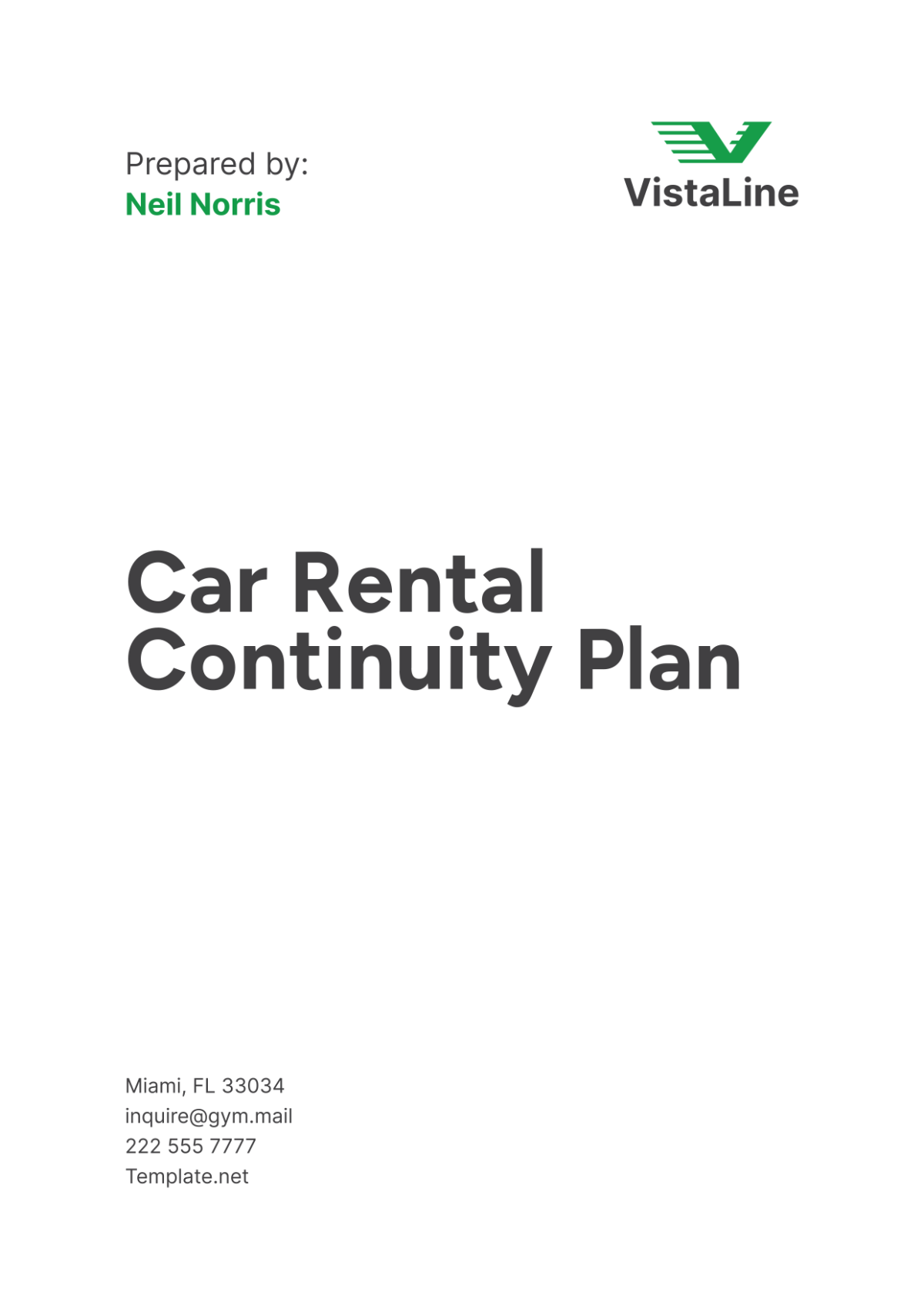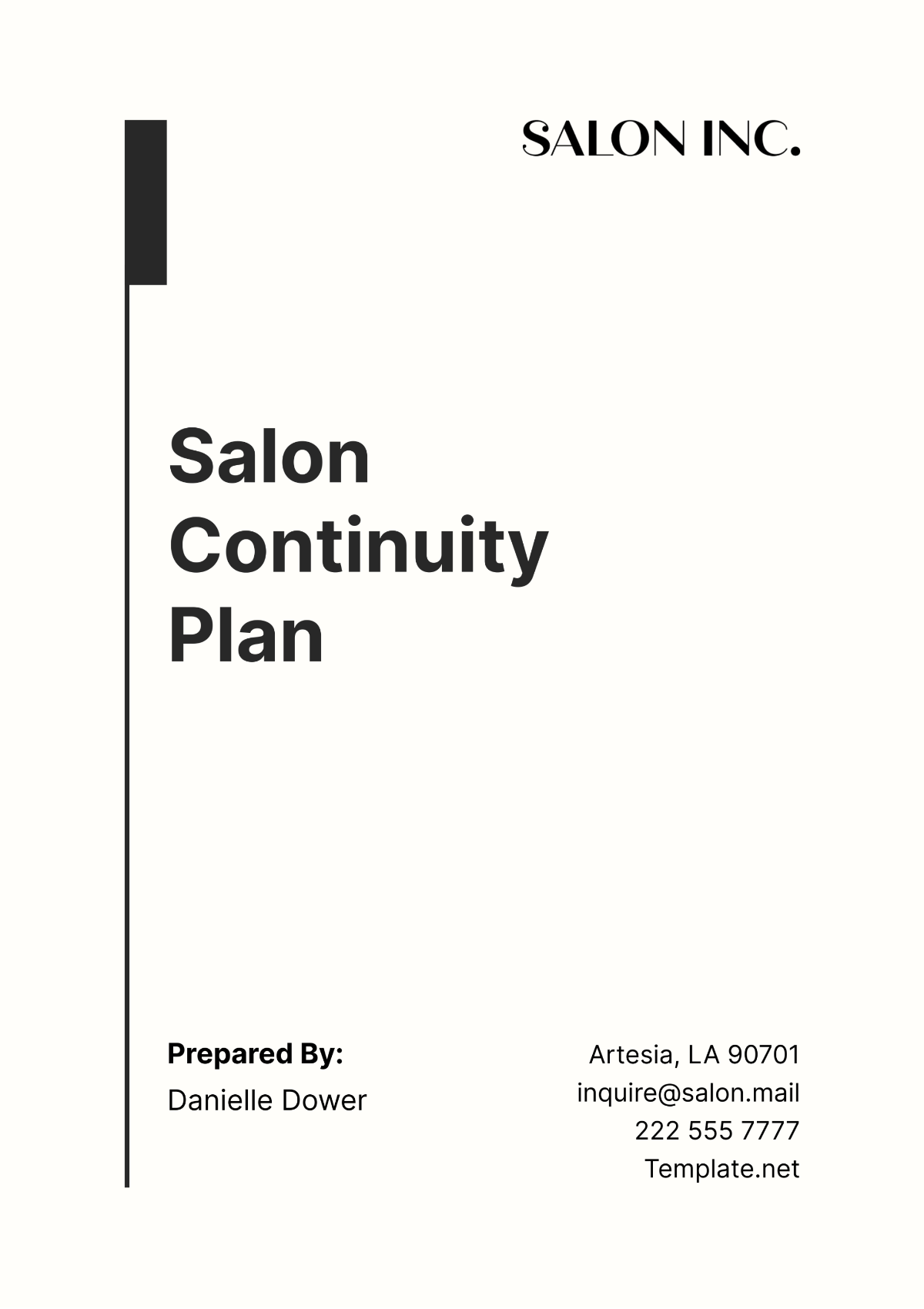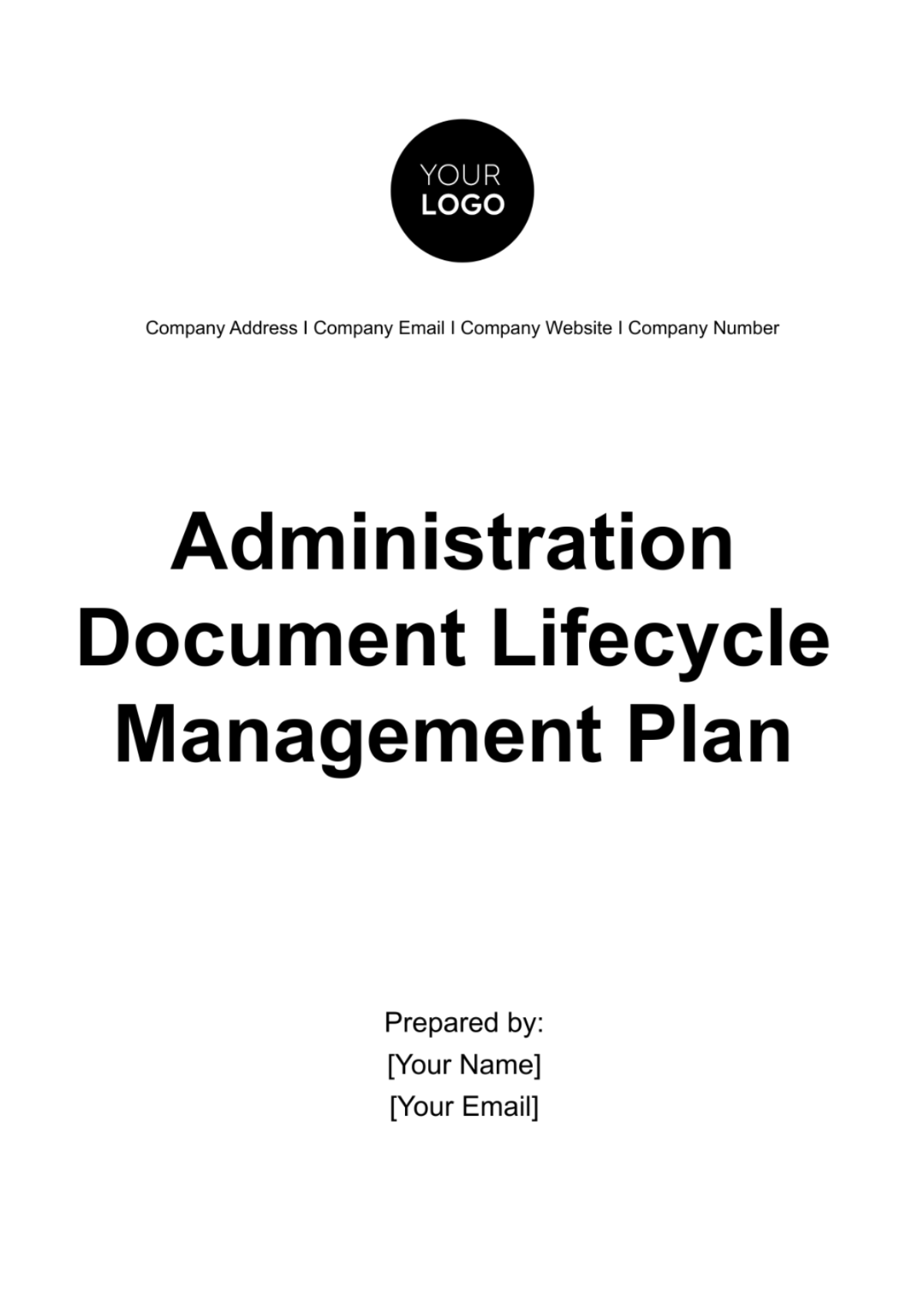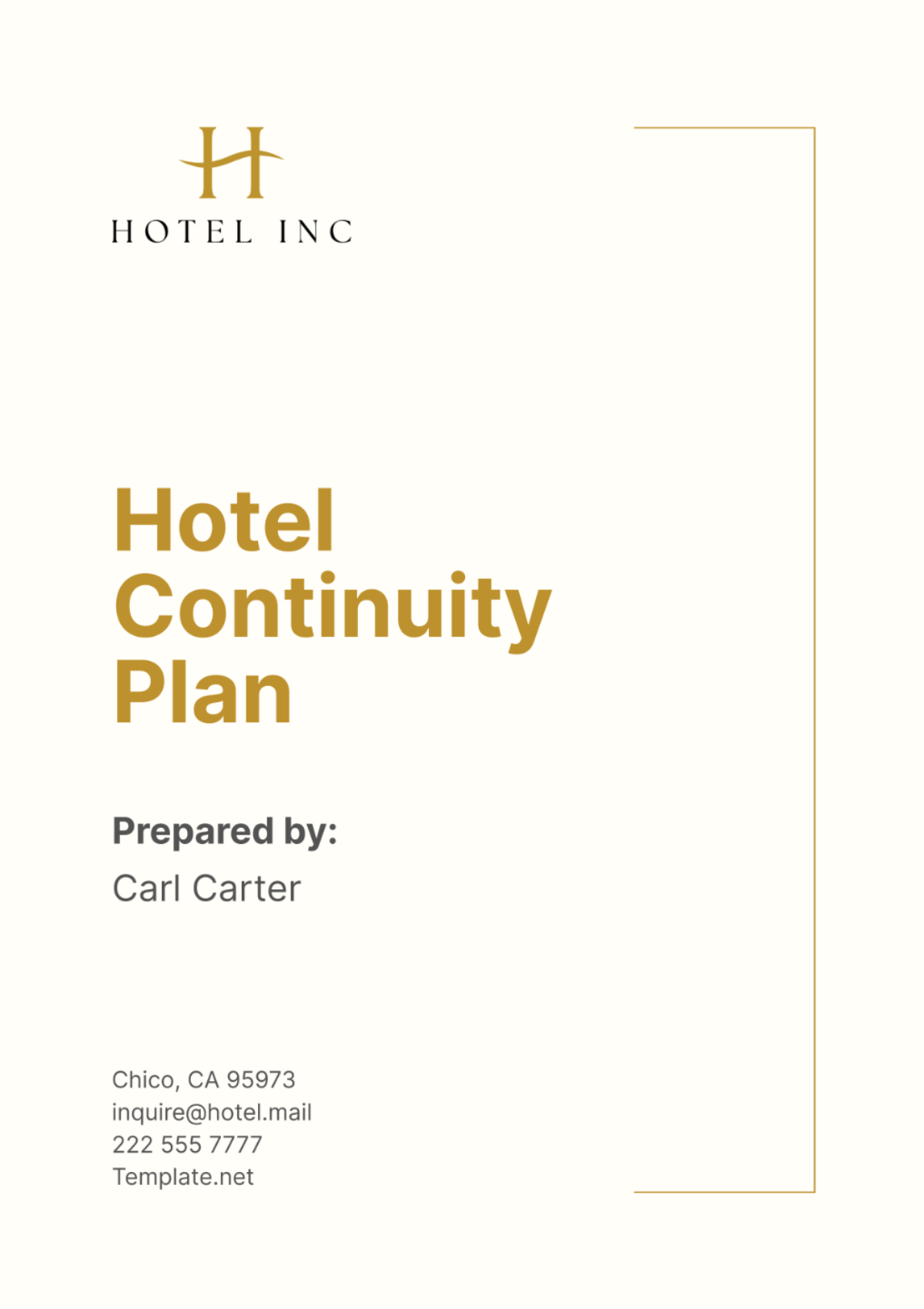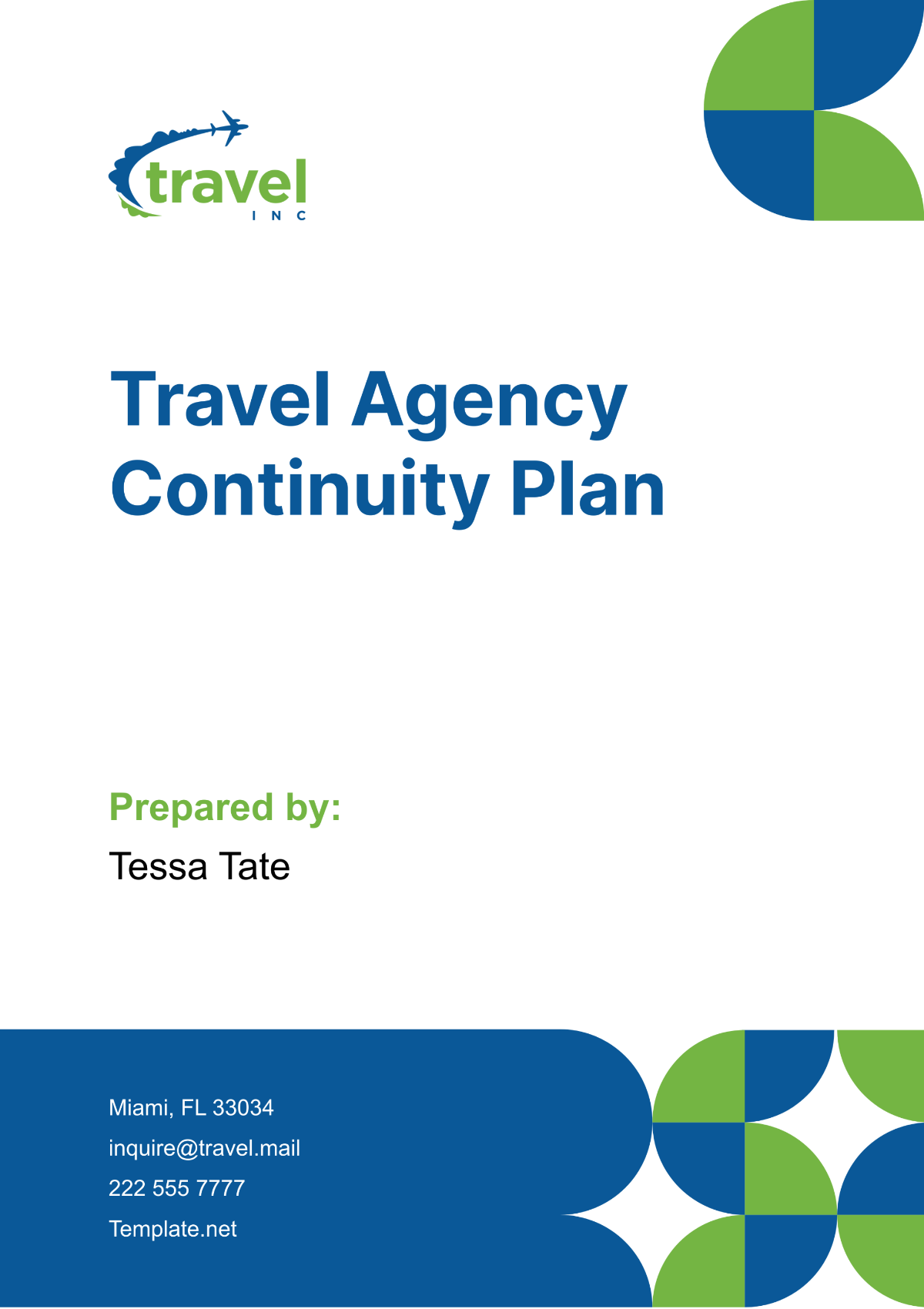Hotel Continuity Plan
I. Introduction
A. Purpose of the Continuity Plan
The Hotel Continuity Plan serves as a roadmap for the hotel staff to follow during emergencies, ensuring a coordinated response and minimizing disruptions to guest services. By outlining clear procedures and responsibilities, the plan aims to mitigate the impact of potential crises, safeguarding the hotel's reputation and financial stability.
B. Scope and Applicability
This plan applies to all personnel, facilities, and operations within the hotel premises, including satellite properties or off-site facilities under the hotel's management. It covers a wide range of potential disruptions, including but not limited to natural disasters, technological failures, security incidents, and public health emergencies, ensuring a comprehensive approach to continuity management.
C. Key Objectives
The Hotel Continuity Plan aims to achieve several key objectives, including ensuring the safety and security of guests, employees, and visitors; maintaining essential hotel functions and services to minimize financial losses and reputational damage; facilitating a swift and efficient response to emergencies through effective communication and coordination; and supporting the hotel's overall business resilience and continuity in the face of adversity.
D. Overview of the Hotel's Operations
The hotel operates 24/7, providing a range of services including accommodation, dining, event hosting, and leisure facilities. Key departments such as Front Office, Housekeeping, Food and Beverage, Maintenance, Security, and Administration work together to ensure smooth operations and exceptional guest experiences. Understanding the interconnectedness of these departments is crucial for effective continuity planning.
II. Risk Assessment and Business Impact Analysis (BIA)
A. Identification of Potential Threats and Hazards
Through a comprehensive risk assessment process, potential threats and hazards to the hotel's operations are identified, including natural disasters (e.g., earthquakes, floods), technological failures (e.g., power outages, IT system crashes), human-caused incidents (e.g., terrorism, sabotage), and public health emergencies (e.g., pandemics, outbreaks). This step involves gathering data on historical events, analyzing industry trends, and consulting with relevant stakeholders to ensure a thorough understanding of potential risks.
B. Evaluation of Vulnerabilities and Risks
The evaluation phase assesses the hotel's vulnerabilities and determines the likelihood and potential impact of identified risks. Vulnerabilities may include weaknesses in infrastructure, dependencies on critical resources, or gaps in emergency preparedness. By quantifying risks based on their likelihood and impact, the hotel can prioritize mitigation efforts and allocate resources effectively to address the most significant threats.
C. Business Impact Analysis
The Business Impact Analysis (BIA) identifies critical business functions and processes essential for the hotel's operations, such as guest accommodation, food and beverage services, and revenue management. It also examines dependencies and interdependencies between departments, suppliers, and external stakeholders, considering how disruptions in one area may cascade across the organization. Understanding the potential consequences of disruptions allows the hotel to develop targeted strategies to minimize impacts and prioritize recovery efforts.
III. Prevention and Mitigation Strategies
A. Measures to Reduce the Likelihood of Disruptions
Proactive measures are implemented to reduce the likelihood of disruptions, including physical security measures such as access controls, surveillance systems, and perimeter security to deter unauthorized access or criminal activities. Cybersecurity protocols are established to safeguard the hotel's digital assets and sensitive information, including regular system updates, firewalls, and employee training on cybersecurity best practices. Additionally, emergency preparedness training sessions are conducted for staff members to ensure they are equipped with the knowledge and skills to respond effectively to emergencies, including first aid training, evacuation procedures, and crisis communication protocols.
B. Strategies to Mitigate the Impact of Disruptions
In addition to preventing disruptions, the hotel develops strategies to mitigate their impact if they occur. Backup power and utilities are prioritized to ensure continuous operation of essential services during power outages or utility failures, with emergency generators, fuel reserves, and redundant systems in place. Emergency communication systems are established to enable swift and effective communication during crises, including two-way radios, mass notification systems, and guest communication channels. Supply chain diversification strategies are implemented to minimize disruptions caused by supplier failures or shortages, including maintaining relationships with multiple suppliers, stockpiling essential supplies, and exploring alternative procurement options.
IV. Response and Recovery Plans
A. Incident Response Procedures
Clear incident response procedures are established to guide hotel staff in effectively managing emergencies as they unfold. Emergency response teams are activated promptly, with designated personnel assuming specific roles and responsibilities outlined in the plan. Crisis communication protocols are implemented to ensure timely and accurate dissemination of information to internal and external stakeholders, including staff members, guests, local authorities, and the media. Guest evacuation and safety measures are prioritized to safeguard the well-being of guests and facilitate orderly evacuations in the event of emergencies, with evacuation routes, assembly points, and guest assistance protocols clearly communicated and practiced.
B. Recovery Strategies
Recovery strategies are developed to facilitate the swift restoration of hotel operations following a disruption. Essential services are prioritized for restoration, with a focus on restoring power, water, and HVAC systems to minimize downtime and ensure guest comfort. Business resumption procedures are established to guide the phased reopening of facilities and services, including staffing plans, facility inspections, and guest relocation assistance if necessary. Post-incident evaluation and improvement plans are implemented to review the hotel's response to the disruption, identify lessons learned, and make necessary revisions to the Continuity Plan to enhance preparedness for future events.
V. Communication and Coordination
A. Internal Communication Protocols
Clear internal communication protocols are established to ensure effective coordination and collaboration among hotel staff during emergencies. A chain of command is defined, outlining roles and responsibilities for key personnel and establishing channels for reporting incidents and escalating issues as needed. Communication channels and tools are identified, including phone trees, messaging apps, and email distribution lists, to facilitate rapid communication and dissemination of critical information to all staff members. Staff training and awareness programs are conducted regularly to ensure that all employees are familiar with emergency procedures, understand their roles and responsibilities, and are prepared to respond effectively in crisis situations.
B. External Communication
Effective external communication is essential for coordinating with external stakeholders and keeping guests, local authorities, and the media informed during emergencies. Guest communication procedures are established to provide timely updates and instructions to guests, including emergency announcements, safety information, and evacuation procedures, through various channels such as in-room notices, public address systems, and digital signage. Coordination with local authorities and emergency services is facilitated to ensure mutual aid and support during emergencies, with designated liaisons responsible for communicating with police, fire, and medical services as needed. Media relations and public statements are managed to provide accurate and consistent information to the media and the public, with designated spokespersons trained to handle media inquiries and disseminate official statements in accordance with the hotel's communication protocols.
VI. Resource Management
A. Staffing Continuity Plans
Cross-Training Programs: Initiate comprehensive cross-training programs to guarantee that employees gain proficiency in a variety of roles and functions across different departments within the hotel. Establishing such programs will foster greater flexibility and adaptability, particularly during emergencies when unforeseen staffing shortages might arise, thus ensuring continuous and efficient hotel operations.
Temporary Staffing Arrangements: Form collaborations with temporary staffing agencies to ensure the ability to promptly augment the workforce during periods of high demand or in emergency situations. Keep contracts current and contact details readily accessible to facilitate swift mobilization.
Volunteer Registers: Establish and maintain a comprehensive volunteer registry within the hotel staff community, which allows and empowers employees who are interested to voluntarily sign up for extra shifts or assume different roles in times of emergencies. Offer thorough training programs and provide attractive incentives for those who choose to volunteer, with the aim of boosting participation rates and ensuring there is an adequate pool of resources available when needed.
B. Inventory Management and Procurement Strategies
Just-in-Time Inventory Practices: Optimize inventory management practices to maintain lean inventories while ensuring sufficient stock levels for critical supplies. Implement automated inventory tracking systems to monitor stock levels in real-time and facilitate timely replenishment.
Emergency Supplies Caches: Establish emergency supplies caches strategically located throughout the hotel to provide immediate access to essential supplies during emergencies. Regularly audit and replenish these caches to ensure readiness.
Alternative Sourcing Options: Identify alternative suppliers and procurement channels for critical supplies to mitigate disruptions caused by supplier failures or shortages. Establish relationships with multiple vendors and negotiate contingency contracts to ensure access to essential resources during emergencies.
C. Financial Preparedness and Contingency Funding
Emergency Reserve Funds: Maintain dedicated emergency reserve funds to cover unexpected expenses and financial losses resulting from disruptions. Establish clear protocols for accessing and allocating these funds during emergencies.
Insurance Coverage: Review and update insurance policies regularly to ensure adequate coverage for potential risks and liabilities associated with hotel operations. Work closely with insurance providers to tailor policies to specific needs and ensure comprehensive protection.
Business Interruption Planning: Develop detailed business interruption plans to mitigate financial losses and facilitate rapid recovery in the event of disruptions. Identify key revenue streams, prioritize critical expenses, and establish protocols for managing cash flow during emergencies.
VII. Testing, Training, and Exercises
A. Regular Testing and Drills
Regular testing and drills are conducted to evaluate the effectiveness of the Hotel Continuity Plan and ensure staff readiness to respond to emergencies. Various crisis scenarios, including natural disasters, security incidents, and public health emergencies, are simulated to assess staff preparedness, identify areas for improvement, and refine response procedures. After-action reports are compiled following each exercise, detailing observations, lessons learned, and recommendations for enhancing the plan's effectiveness.
B. Evaluation of Response and Recovery Procedures
Response and recovery procedures are evaluated based on observations and feedback gathered during testing and drills. Key performance indicators, such as response times, communication effectiveness, and resource allocation, are assessed to measure the hotel's ability to manage emergencies and minimize disruptions. Lessons learned from each exercise are documented and used to update response and recovery plans, improve staff training programs, and enhance overall preparedness for future events.
VIII. Documentation and Maintenance
A. Documenting the Continuity Plan
The Hotel Continuity Plan is documented in detail, outlining procedures, protocols, and responsibilities for all aspects of emergency preparedness, response, and recovery. A structured document repository is maintained to store the plan and associated documentation, with version control mechanisms to track revisions and ensure that all stakeholders have access to the most up-to-date information. A roles and responsibilities matrix is included, specifying the duties of key personnel and departments during emergencies, and a contact directory is provided, listing emergency contact numbers, vendor contacts, and other relevant information.
B. Plan Maintenance and Review
The Hotel Continuity Plan is subject to regular maintenance and review to ensure its continued effectiveness and relevance. An annual review cycle is established, during which the plan is updated based on changes in the hotel's operations, infrastructure, or external environment, as well as lessons learned from testing and exercises. Change management procedures are implemented to track revisions and ensure that all stakeholders are informed of updates to the plan. Compliance with regulatory requirements is monitored, and the plan is adjusted as needed to align with industry standards, legal obligations, and best practices. Documentation of plan changes, including revision memos, policy updates, and staff training records, is maintained to provide a clear audit trail of revisions and ensure accountability for plan maintenance and review.
IX. Appendices
A. Glossary of Terms
A comprehensive glossary of terms has been included in order to clarify any technical or industry-specific terminology that is utilized within the context of the Hotel Continuity Plan. This is done with the intent of ensuring that all stakeholders involved have a shared and clear understanding of the key concepts and terminology essential to the plan.
B. References and External Resources
Included in the document is a comprehensive list of references and external resources, which offers additional information, guidance, and best practices essential for understanding and implementing effective strategies in emergency preparedness, business continuity, and crisis management.
C. Supporting Documentation (e.g., Maps, Floor Plans)
Supporting documentation, such as maps, floor plans, and facility diagrams, is included to aid in emergency planning and response efforts, providing visual references and guidance for staff and emergency responders. These documents may include evacuation routes, assembly points, utility shut-off locations, and other relevant information to assist in navigating and managing emergencies within the hotel premises.
